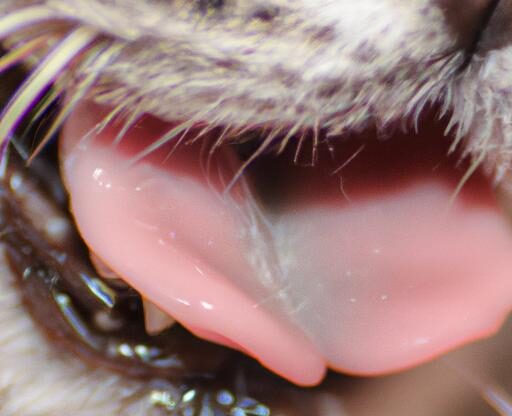Cat Cancer Under Tongue: Understanding the Importance of Early Detection and Treatment
Cats, our beloved companions, bring joy and warmth to our lives. We want nothing more than to ensure their health and happiness. However, sometimes they can face obstacles, such as cat cancer under the tongue. In this article, we will explore the significance of early detection and treatment when it comes to this specific type of feline cancer.
A Brief Explanation of Cat Cancer Under the Tongue
Cat cancer under the tongue, also known as oral cancer or oral squamous cell carcinoma, is a malignant growth that develops beneath the tongue of our feline friends. This aggressive form of cancer can spread rapidly, affecting various parts of their oral cavity. It is essential to be aware of this condition and take prompt action if any concerning symptoms arise.
Importance of Early Detection and Treatment
Detecting cat cancer under the tongue in its early stages can significantly influence the prognosis and treatment outcomes. Like any cancer, early intervention provides a better chance of successful treatment and increased survival rates. Regular health check-ups and vigilant observation of your cat’s behavior and physical wellbeing play a crucial role in identifying any abnormalities.
If left undetected or untreated, cat cancer under the tongue can cause severe pain, difficulty in eating and swallowing, weight loss, and even metastasis to other parts of the body. By staying alert and addressing any potential concerns promptly, we can improve the quality of life for our feline companions.
So, how can we recognize the signs of cat cancer under the tongue? What steps should we take if we suspect our beloved cat may be affected? Join me in the following sections as we dive deeper into understanding the symptoms, diagnosis, treatment options, and prevention strategies for this condition. Together, we can equip ourselves with the knowledge needed to protect our furry friends from the clutches of this disease.
Remember, your cat’s health is in your hands. Let’s explore further and ensure we can provide the best care possible in the battle against cat cancer under the tongue.
Stay tuned for Section II: Understanding Cat Cancer Under the Tongue, where we delve into the intricacies of this condition and explore the types of cancer commonly found beneath the tongue in our feline friends.
Understanding Cat Cancer Under the Tongue
Overview of Oral Cancer in Cats
Oral cancer in cats is a serious health concern that requires our attention. Feline oral tumors can originate from various parts of the mouth, including the tongue. Of these, cat cancer under the tongue, specifically oral squamous cell carcinoma, is one of the most frequently diagnosed types. This aggressive form of cancer can rapidly progress, causing significant discomfort and affecting the overall well-being of our feline companions.
Types of Cancer Commonly Found Under the Tongue
When it comes to cat cancer under the tongue, oral squamous cell carcinoma is the primary culprit. This malignant tumor usually develops in the squamous cells lining the mouth’s oral cavity. Squamous cell carcinoma is known for its tendency to invade surrounding tissues, making early detection crucial for effective treatment.
Causes and Risk Factors Associated with Cat Cancer Under the Tongue
While the exact causes of cat cancer under the tongue remain unclear, several risk factors have been identified. Exposure to environmental carcinogens, such as secondhand smoke and certain chemicals, may increase the likelihood of developing oral tumors. Additionally, chronic dental disease, poor oral hygiene, and viral infections, such as feline leukemia virus (FeLV) and feline immunodeficiency virus (FIV), can contribute to the development of oral cancer in cats.
It’s important to note that certain breeds, such as Siamese and Abyssinian cats, have shown a higher predisposition to developing oral tumors. Age also plays a role, with older cats being more susceptible.
By understanding the overview, types, and factors associated with cat cancer under the tongue, we can better comprehend the complexity of this condition. In the next section, we will explore the common symptoms that may indicate the presence of this disease. Join me as we unveil the signs that warrant our attention and prompt veterinary assistance.
Stay tuned for Section III: Symptoms of Cat Cancer Under the Tongue, where we unravel the physical and behavioral indicators that may signify the presence of this condition in our feline companions.
Symptoms of Cat Cancer Under the Tongue
As responsible cat owners, it is crucial to familiarize ourselves with the symptoms that may indicate the presence of cat cancer under the tongue. By recognizing these signs early on, we can take the necessary steps to seek veterinary assistance and ensure the best possible outcome for our furry companions.
A. Physical signs to look out for
-
Visible Tumors or Lesions: Inspect your cat’s mouth regularly and look for any abnormal growths, ulcers, or lesions under the tongue. These may appear as lumps, bumps, or discolored areas.
-
Swelling and Inflammation: Watch for any swelling or inflammation beneath the tongue. This can manifest as a noticeable enlargement or redness in the affected area.
-
Bleeding or Discharge: Be cautious of any unexplained bleeding or discharge from the mouth. Bloodstains on toys, food, or water bowls may indicate an underlying issue.
-
Pain or Discomfort: Cats may exhibit signs of discomfort or pain, such as increased salivation, reluctance to eat, or pawing at the mouth. Keep an eye out for these distress signals.
B. Behavioral changes that may indicate the presence of cancer
-
Changes in Eating Habits: Observe if your cat experiences a sudden loss of appetite or difficulty in eating and swallowing. Weight loss can also be a significant indicator of an underlying issue.
-
Altered Grooming Behavior: Cats are meticulous groomers, so any changes in their grooming routine may signify discomfort or pain. Pay attention to reduced grooming or excessive drooling.
-
Halitosis or Foul Breath: Notice any persistent bad breath that is not alleviated by regular dental hygiene. Foul breath can be an indication of oral health problems, including cat cancer under the tongue.
C. When to seek veterinary assistance
It is crucial to consult a veterinarian if you notice any of the aforementioned symptoms or suspect cat cancer under the tongue. Early intervention is key to providing the best chances for successful treatment and improved quality of life for your cat.
Remember, as a pet owner, you play a vital role in advocating for your cat’s health. Stay vigilant, and if you have any concerns, don’t hesitate to seek professional advice. In the next section, we will explore the diagnosis and treatment options available for cat cancer under the tongue, shedding light on how we can combat this condition effectively.
Stay tuned for Section IV: Diagnosis and Treatment Options, where we delve into the methods used by veterinarians to diagnose cat cancer under the tongue and the various treatment options available to combat this disease.
Section IV: Diagnosis and Treatment Options
When it comes to cat cancer under the tongue, timely diagnosis and appropriate treatment options are paramount. In this section, we will explore the crucial steps involved in diagnosing this condition and the various treatment options available to combat it.
Veterinary Examination and Tests for Cat Cancer Under the Tongue
If you suspect that your cat may be suffering from cancer under the tongue, seeking veterinary assistance is vital. A thorough examination by a qualified veterinarian is the first step towards an accurate diagnosis. During the examination, the vet will assess your cat’s oral cavity, looking for any visible abnormalities or tumors. They may also palpate the area to check for any swelling or unusual growths.
To confirm the diagnosis, additional tests may be necessary. These tests can include blood work, imaging techniques such as X-rays or ultrasounds, and even biopsies. Biopsies play a crucial role in determining the type and stage of the cancer, enabling veterinarians to develop an effective treatment plan.
Treatment Options Available, Including Surgery, Radiation, and Chemotherapy
Once a diagnosis of cat cancer under the tongue is confirmed, various treatment options can be considered. The choice of treatment depends on several factors, including the type and stage of the cancer, the overall health of the cat, and the preferences of the pet owner. Here are some common treatment options:
Surgery:
Surgical intervention aims to remove the tumor and any affected tissues. In some cases, partial or complete removal of the tongue may be necessary. While this may impact your cat’s ability to eat and groom, cats are remarkably adaptable, and with proper care, they can still lead fulfilling lives.
Radiation Therapy:
Radiation therapy utilizes high-energy beams to target and destroy cancer cells. This treatment option may be recommended before or after surgery to ensure that any remaining cancer cells are eliminated. Radiation therapy is administered in multiple sessions over several weeks, with the goal of minimizing discomfort and side effects.
Chemotherapy:
Chemotherapy involves the use of drugs to destroy cancer cells throughout the body. It can be administered orally or intravenously. Chemotherapy may be recommended in cases where surgery or radiation alone may not be sufficient to control the cancer or if there is evidence of metastasis.
Potential Side Effects and Complications of Treatment
While treatment options aim to eradicate cancer, it’s essential to be aware of potential side effects and complications. Surgery may lead to temporary or permanent changes in eating habits and grooming behaviors. Radiation therapy and chemotherapy may cause temporary side effects such as fatigue, nausea, and hair loss. However, these side effects are typically manageable, and veterinarians can provide supportive care to alleviate any discomfort experienced by your feline companion.
In the next section, we will discuss the prognosis for cats with cancer under the tongue and explore preventive measures that can be taken to protect our feline friends from this condition.
Stay tuned for Section V: Prognosis and Prevention, where we delve into the outlook for cats with cancer under the tongue and discuss strategies for prevention.
Prognosis and Prevention
Discussing the Prognosis for Cats with Cancer Under the Tongue
When it comes to cat cancer under the tongue, understanding the prognosis is crucial for both cat owners and veterinarians. The prognosis of this condition depends on various factors, including the stage of cancer, the cat’s overall health, and the chosen treatment approach.
Early detection plays a pivotal role in improving the prognosis. If the cancer is diagnosed in its initial stages, the chances of successful treatment and a more favorable prognosis are significantly higher. However, if the cancer has advanced or spread to other parts of the body, the prognosis may be less optimistic.
It’s important to consult with a veterinarian who specializes in feline oncology to assess the individual case and determine the best course of action. They can provide insights into the specific prognosis based on the cat’s condition, enabling cat owners to make informed decisions regarding treatment and care.
Steps to Prevent Cat Cancer Under the Tongue
While we cannot guarantee complete prevention, there are steps we can take to minimize the risk of cat cancer under the tongue. By implementing these preventive measures, we can promote our feline friends’ well-being and potentially reduce the likelihood of developing this devastating disease.
1. Regular Oral Hygiene: Maintaining good oral hygiene for your cat is paramount. Brushing their teeth regularly with feline-friendly toothpaste helps remove plaque and tartar buildup, reducing the risk of oral health issues.
2. Balanced Diet: Providing a balanced and nutritious diet can contribute to overall health and bolster the immune system, potentially reducing the risk of cancer development.
3. Avoiding Harmful Substances: Limit your cat’s exposure to carcinogens such as tobacco smoke, household chemicals, and pesticides. These substances have been linked to an increased risk of various cancers, including oral cancer.
4. Environmental Enrichment: Ensuring your cat has a stimulating and stress-free environment can help boost their overall health and well-being. A happy and content cat may be at a lower risk of developing certain health conditions.
Regular Oral Hygiene and Veterinary Check-ups
To maintain your cat’s oral health and catch any potential issues early on, regular dental care and veterinary check-ups are essential. Professional dental cleanings can aid in preventing oral health problems and allow veterinarians to identify any abnormalities promptly.
Additionally, scheduling routine veterinary check-ups enables early detection of any signs or symptoms that may indicate the presence of cat cancer under the tongue. Your veterinarian can perform thorough examinations, including oral inspections, to identify any concerning changes.
Remember, prevention and early detection are key in the fight against cat cancer under the tongue. By implementing preventive measures and staying proactive in your cat’s oral health, you can help safeguard their well-being and potentially extend their years of purrs and cuddles.
Stay tuned for Section VI: Support and Care for Cats with Cancer Under the Tongue, where we explore the different ways we can provide support for our feline friends facing this challenging condition, while also offering emotional support for their dedicated owners.
Conclusion
In conclusion, cat cancer under the tongue is a serious condition that requires our attention and swift action. Early detection and treatment are paramount to improving the prognosis and overall well-being of our feline companions.
By understanding the signs and symptoms associated with cat cancer under the tongue, we can be proactive in seeking veterinary assistance. Regular check-ups and observing any changes in behavior or physical appearance are essential for early intervention.
Diagnosis and treatment options vary, but they may include surgery, radiation, and chemotherapy. While these treatments may have potential side effects, they aim to eliminate or control the cancer cells, providing our cats with a better chance at a longer and healthier life.
Prevention is also crucial in the battle against cat cancer under the tongue. Maintaining good oral hygiene practices, providing a balanced diet, and minimizing exposure to carcinogens can significantly reduce the risk of developing this condition.
As cat owners, it is our responsibility to provide support and care for our furry friends throughout their journey with cancer. Palliative care options can help manage pain and improve their quality of life, while emotional support for both the cat and the owner is equally important.
Remember, early detection, timely treatment, and a supportive environment can make a world of difference for cats facing cancer under the tongue. Let’s stay vigilant, educate ourselves, and take the necessary steps to protect and care for our beloved feline companions.
Together, we can make a difference in the lives of our cats and pave the way for a brighter future, free from the grasp of cat cancer under the tongue.
Thank you for joining me on this informative journey. If you have any questions or concerns, feel free to reach out. Wishing you and your furry friends health and happiness always.





